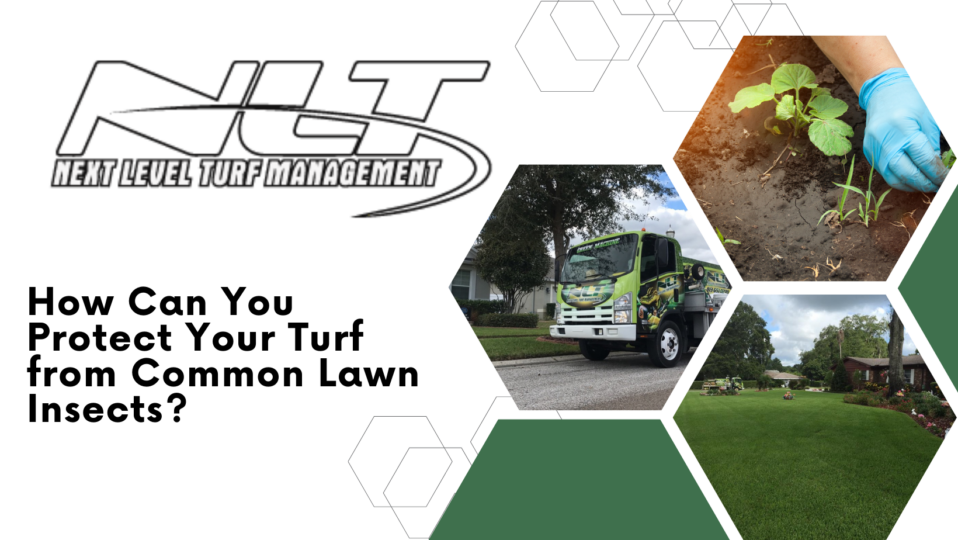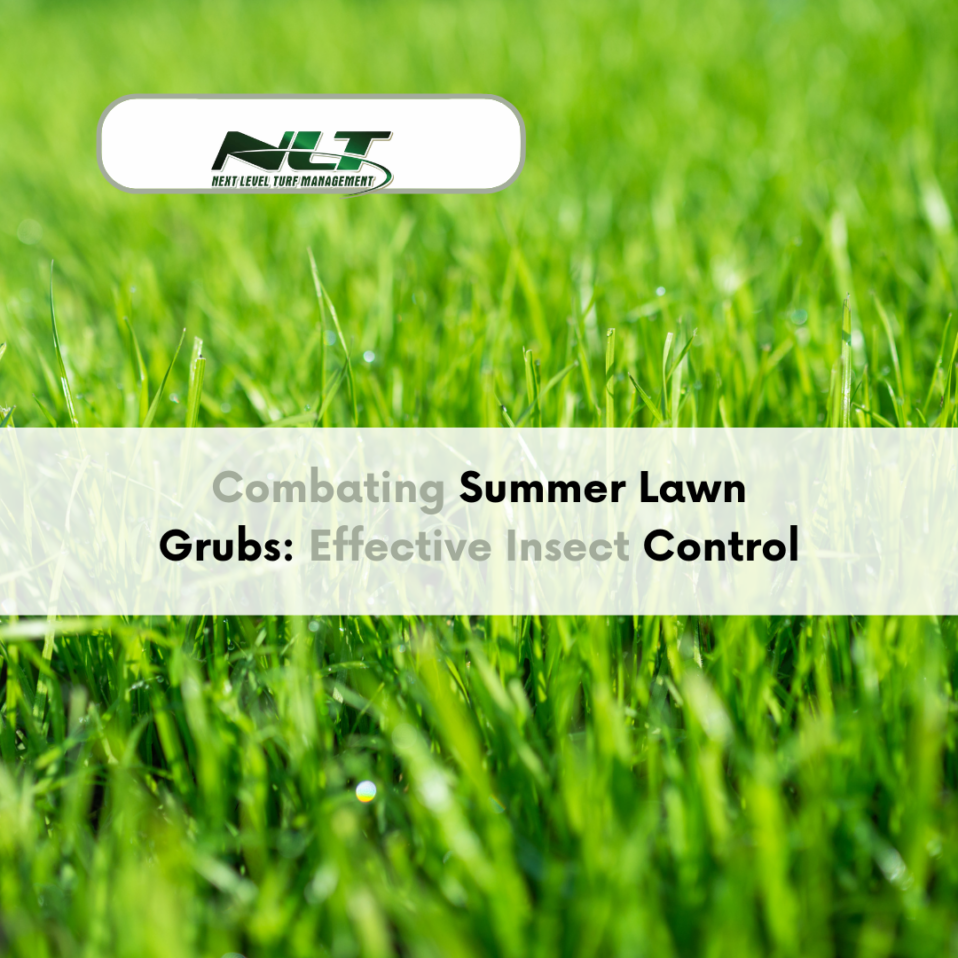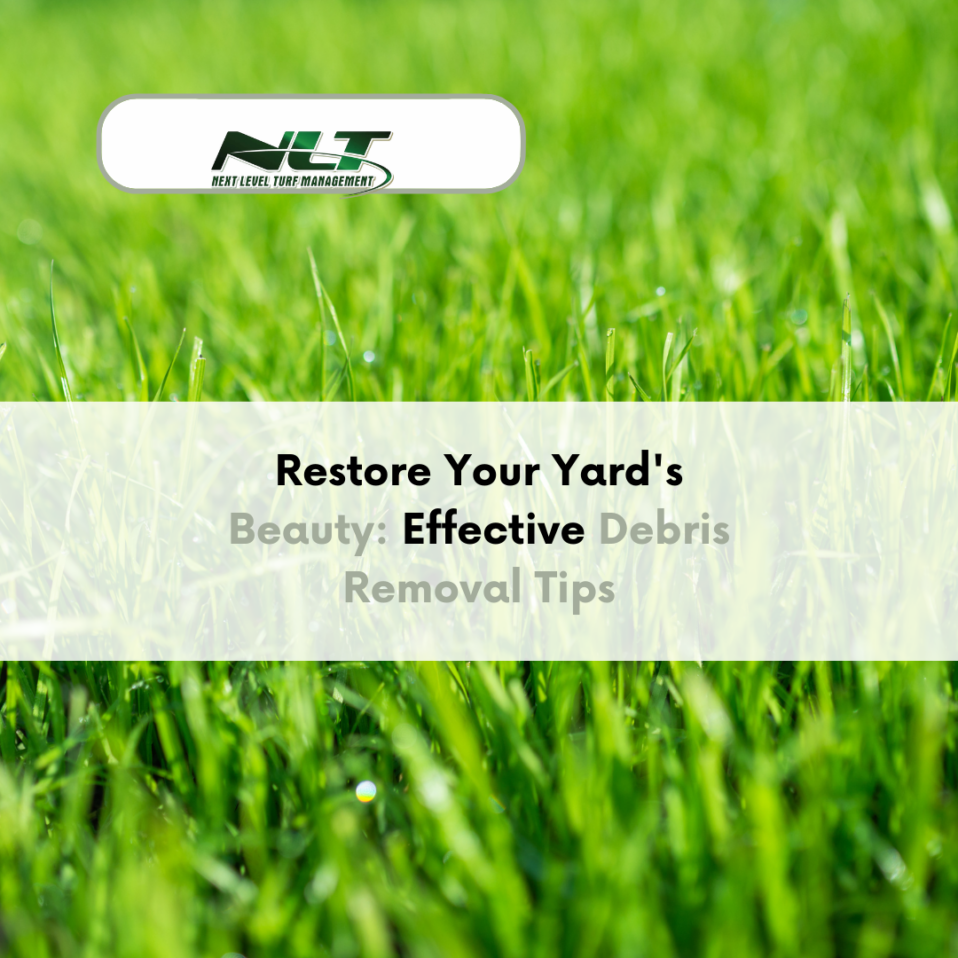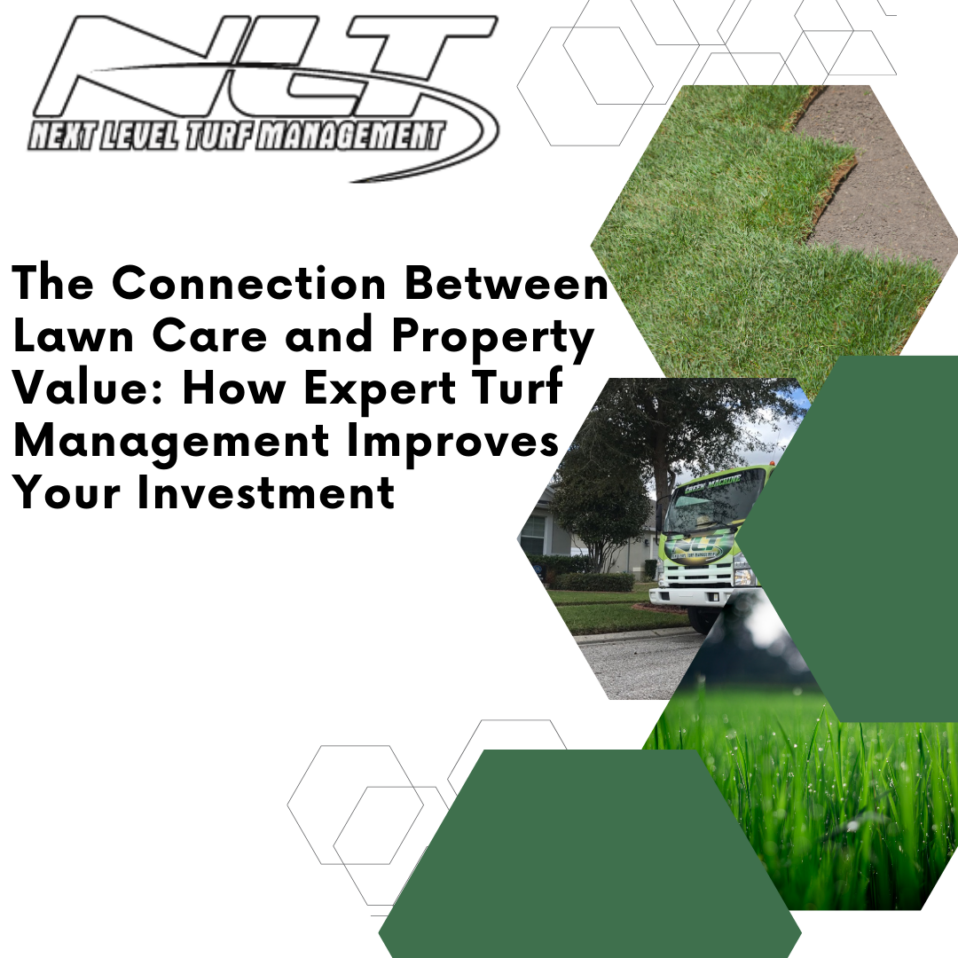protect your turf
Protect your turf – A vibrant, healthy lawn can be the pride of any homeowner or business owner. However, insects and pests can pose a threat to its beauty and functionality. With hundreds of species of insects found throughout Central Florida, it can be challenging to maintain your lawn’s health, particularly when some insects can cause significant damage to your turf.
Fortunately, effective lawn insect control is within reach. As a homeowner or business owner in Central Florida, you must understand which insects are most prominent in this region, what damage they can cause, and how to protect your turf effectively. By learning about prevention strategies, identifying problems early, and implementing targeted treatment solutions, you can protect your lawn from these pesky, unwanted guests. protect your turf
As Central Florida’s premier turf management company, Next Level Turf is dedicated to helping you keep your lawn free from common lawn insects. In this blog post, we will discuss some of these problematic insects and their impact on your turf, providing you with actionable tips and information to keep your lawn in top-notch condition. With the right approach, maintaining a healthy, resilient lawn in the face of these pests is much more manageable. So let’s dive in! protect your turf
Identify the Top Culprits: Common Lawn Insects in Central Florida
The first step in protecting your lawn from insects is knowing which pests are likely to threaten it. In Central Florida, several insects commonly disrupt lawn quality and health. Here are three of the most problematic insects: protect your turf
- Chinch Bugs: Chinch bugs are small, black insects with white wings. They thrive in the warm, sunny conditions found throughout Central Florida and can cause significant damage to your lawn, particularly St. Augustine grass. Chinch bugs feed on grass blades, extracting nutrients and moisture, and injecting toxic saliva into the grass, which causes it to die. As a result, your turf may develop dead patches, yellowing, and overall thinning. These dead patches, often mistaken for drought stress, can spread quickly if not addressed in a timely manner.
- Sod Webworms: Sod webworms are the larvae of a group of moths known as lawn moths. They are small, grayish-brown insects that prefer warm-season grasses like Bermuda and St. Augustine grass. Sod webworms primarily feed at night, avoiding detection during the day by hiding in the thatch layer of your lawn. They often cause irregular patches of dead or damaged grass, as well as frayed, chewed grass blades. When sod webworm infestations are severe, your lawn may develop large, dead patches that invite further problems, such as weed invasion.
- Southern Mole Crickets: Southern mole crickets are one of the most destructive lawn pests in Central Florida. These insects can tunnel through the soil at an incredible rate, causing significant damage to the root systems of your grass. Their tunneling behavior often leads to a spongy texture in your lawn and allows for the growth of opportunistic weeds. In addition, their feeding habits can severely impact the health and resilience of your turf, leading to an overall decline in lawn quality.
Prevention is Key: Proactive Strategies to Protect Your Lawn
A proactive approach to lawn care is essential for keeping these pests at bay and maintaining a healthy, attractive lawn. Here are four key strategies for preventing insect infestations on your turf:
- Practice proper lawn maintenance: Regular mowing, watering, and fertilization are crucial for achieving a healthy, pest-free lawn. Mow your grass at the appropriate height for your specific type of turf, and water deeply and infrequently to encourage deep root growth. Be sure to fertilize according to a schedule tailored to your lawn’s needs, as an imbalanced nutrient supply can create a welcoming environment for pests.
- Monitor your lawn for signs of insect damage: Regularly inspect your turf for any signs of insect activity, such as dead patches, yellowing, or chewed grass blades. Catching an infestation early allows you to address the problem quickly, before it spreads or causes extensive damage.
- Maintain a healthy, balanced soil ecosystem: Beneficial insects, such as ladybugs and ground beetles, can help keep harmful pest populations in check. Encourage their presence in your yard by providing a habitat for them, such as mulched areas, or by planting flowers and plants that attract them.
- Seek professional help: In many cases, it is beneficial to enlist the help of a turf management professional who can assess your lawn’s unique needs and create a customized insect control plan. Their expertise can help you identify potential issues and address them before they become severe problems. protect your turf
Early Detection and Intervention: Targeted Treatments for Lawn Insects
When signs of an infestation become apparent, swift action is crucial to prevent further damage. Here are some targeted treatment options for dealing with common lawn insects:
- Chinch bug treatment: For chinch bugs, insecticides can be applied directly to the affected areas of your lawn. Be sure to choose a product specifically labeled for chinch bugs and follow the manufacturer’s application instructions. It is essential to apply insecticides in the late spring or early summer when the pests are most active to ensure the highest level of effectiveness.
- Sod webworm treatment: For sod webworms, an insecticide treatment containing Bacillus thuringiensis (Bt) or another approved ingredient can be applied to targeted areas. Ensure to use a labeled product for sod webworm control and thoroughly water the treatment into the soil, as this helps to distribute the insecticide to the larvae that are hiding in the thatch layer.
- Mole cricket treatment: For mole cricket control, targeted insecticide applications are highly effective. An insecticide containing a labeled active ingredient, such as bifenthrin, can be applied to the affected areas during the insects’ peak activity months, which are typically late spring and early fall. Additionally, proper watering is critical to the effectiveness of mole cricket treatments, as it helps ensure the insecticide infiltrates the soil where the insects reside.
In all cases, it is crucial to be mindful of the environmental impact of insecticides and to use them only when necessary for controlling pests. Continued monitoring and preventative measures are essential for long-term success in managing lawn pest issues. protect your turf
Strengthen Your Lawn’s Natural Defenses: Building a Resilient Turf
One of the best ways to protect your lawn from insect damage is to create a strong, healthy turf that can better withstand the effects of pest activity:
- Choose the right grass: Selecting a grass variety suited to your region’s climate and soil conditions is an essential first step in building a resilient lawn. In Central Florida, warm-season grasses, such as St. Augustine and Zoysia grass, are preferred for their ability to tolerate the heat and humidity.
- Improve soil quality: Ensuring that your lawn has a nutrient-rich, well-draining soil is vital for its overall health. Poor-quality soil can leave your turf more vulnerable to insect damage and other problems. Regularly test your soil to identify any nutrient deficiencies or imbalances, and make adjustments as necessary with appropriate supplements and amendments.
- Overseed your lawn: Regularly overseeding your lawn can help to maintain density and thickness, ultimately creating a stronger, more resilient turf. A dense lawn is less likely to be invaded by common lawn insects and is better equipped to recover from any potential damage.
- Aerate your soil: Periodically aerating your lawn can improve oxygen exchange, nutrient availability, and overall soil health. This practice helps to create a more robust root system, making your turf more resistant to insect damage and improving its ability to recover from stress. protect your turf
Consult the Experts: The Benefits of Professional Lawn Care Services
While it is possible to manage many lawn insect problems independently, professional lawn care services can provide valuable support in handling these issues. Partnering with a turf management company, such as Next Level Turf, will give you access to expert knowledge, specialized equipment, and tailored treatment plans to address any infestations you may encounter. Some benefits of professional lawn care services include:
- Accurate pest identification: By working with a professional, you can be confident that the pests affecting your lawn are properly identified, ensuring that the correct treatment is applied.
- Customized treatment plans: Your lawn’s unique needs and conditions will be considered when creating an insect control plan. A tailored solution will likely be more effective and efficient than a one-size-fits-all approach.
- Ongoing support and monitoring: A professional lawn care service can help you stay on top of any potential pest issues through regular monitoring visits, providing peace of mind and a consistently healthy lawn.
With a comprehensive approach to lawn care, including prevention, early intervention, and building a resilient turf, it is possible to keep common lawn insects at bay and maintain a vibrant, healthy lawn. For the best possible results, consider partnering with Next Level Turf, Central Florida’s premier turf management company, for expert support in creating and maintaining the perfect lawn for your home or business.
The Role of Natural Predator Insects in Pest Control protect your turf
One of the most effective and eco-friendly ways to manage pests is to encourage the presence of beneficial insects in your lawn. These natural predators can significantly reduce the population of harmful insects, providing a sustainable solution for lawn insect control. Some common beneficial insects include:
- Ladybugs: These small, spotted insects are voracious predators of soft-bodied pests, such as aphids, mealybugs, and even chinch bug nymphs. You can attract ladybugs to your yard by planting flowers that provide nectar and pollen, such as marigolds, zinnias, or sunflowers.
- Green Lacewings: Green lacewings, also known as “aphid lions,” are highly effective predators of various soft-bodied pests. Similar to ladybugs, they can be attracted to your lawn by providing nectar and pollen-rich plants, such as cosmos, dill, or fennel.
- Parasitic Wasps: These small wasps can help control many insects, including sod webworms and various caterpillar species. Adult wasps feed on nectar, and certain plants can attract them to your garden.
By encouraging a diverse ecosystem in your yard, including beneficial predator insects, you can create a more robust defense against harmful lawn pests. protect your turf
Implementing an Integrated Pest Management (IPM) Approach for Lawn Insects
An Integrated Pest Management (IPM) approach combines multiple tactics to prevent and manage pests, effectively minimizing both environmental impact and future infestations. Implementing an IPM plan for your lawn incorporates the following steps:
- Monitor and identify lawn pests: Regularly inspect your lawn for signs of insect activity and correctly identify the pests responsible for any damage.
- Set action thresholds: Determine the pest population levels at which it is necessary to implement control measures. Not every insect sighting requires intervention; it’s essential to balance the presence of both harmful and beneficial insects. protect your turf
- Employ preventive cultural practices: As discussed earlier, proper lawn maintenance, healthy soil, and promoting beneficial insects are all crucial factors in preventing pest infestations.
- Utilize targeted mechanical or biological controls: If pests become a significant issue, consider introducing natural predators, applying biological treatments such as Bt insecticides, or employing mechanical approaches like hand-picking pests from the affected areas.
- Apply chemical controls when necessary: Chemical insecticides should be used as a last resort when all other control methods have proven ineffective. When using chemical treatments, opt for the least toxic and most targeted options, following label instructions diligently.
An IPM approach focuses on long-term pest prevention and minimal environmental impact, making it a sustainable and effective method for lawn insect control. protect your turf protect your turf
Communicating with Neighbors for Collaborative Lawn Pest Management
Pests can quickly spread from one lawn to another. By collaborating with neighbors and sharing information about insect control strategies, you can better manage pests on a broader scale. Consider discussing pest management plans or arranging group consultations with local turf management professionals, like Next Level Turf, to foster a community-wide approach to preventing and managing lawn pests.
Recognizing the Limitations of DIY Pest Control
While it is possible to manage some pest infestations independently, there are instances where the expertise of a professional turf management company is necessary. For example, if you have tried multiple intervention methods and the insect problem persists, or if you are dealing with a severe infestation, seeking professional assistance is highly recommended. Additionally, improper application of chemical insecticides can lead to environmental harm and may even exacerbate insect issues. In such cases, rely on the experts for guidance and appropriate intervention.
Lawn Pest Prevention: The Role of Proper Irrigation
Water is critical for maintaining a healthy and beautiful lawn, but improper watering practices can inadvertently make your turf more inviting to pests. Here are some ways to ensure that your irrigation practices contribute to pest prevention:
- Water deeply and infrequently: Instead of watering your lawn every day for short periods, aim to water twice a week for longer durations. This promotes deeper root growth and reduces the amount of standing water in your yard, which can attract pests like mosquitoes.
- Water during the early morning: Watering in the early morning hours reduces evaporation, ensuring that your grass receives the necessary moisture. It also allows the turf to dry throughout the day, preventing fungal growth that attracts pests.protect your turf
- Monitor moisture levels: Overwatering your lawn can lead to shallow root systems and reduced tolerance to pests. Use a soil moisture meter to gauge your lawn’s moisture levels and adjust your watering schedule accordingly. protect your turf
Understanding the Impact of Lawn Pests on Your Home’s Value
A beautiful, well-maintained lawn can increase your property value, but a pest-infested lawn can have the opposite effect. Prospective home buyers may perceive an insect-ridden lawn as an indication of poor lawn care practices or neglect. By keeping your lawn pest-free, you can enhance your property’s curb appeal and ensure a higher resale value.
Take Advantage of Current Pest Control Technologies
Stay informed about the latest pest control technologies and techniques to continuously fine-tune your lawn’s insect management approach. For example, new biological control agents, such as beneficial nematodes, may prove useful in controlling chinch bug, mole cricket, and sod webworm infestations. Furthermore, advancements in chemical control products, such as reduced-risk insecticides or innovative formulations designed for higher efficacy, can improve your ability to manage lawn pests effectively. protect your turf
The Importance of Educating Yourself on Lawn Pest Control Best Practices
Knowledge is power when it comes to maintaining a pest-free lawn. Stay informed about the different types of pests found in your area, the signs of infestation, and the best practices for managing them. Ultimately, the more you know about lawn pests and their control strategies, the better equipped you will be to handle infestations and maintain a healthy, beautiful lawn.
Protecting your turf from common lawn insects is integral to preserving the beauty and health of your outdoor space. A comprehensive approach, including proper identification of pests, preventive strategies, targeted treatments, and collaboration with professional lawn care services, such as Next Level Turf, is crucial for effective pest management. By implementing these steps in your lawn care routine, you can keep your Central Florida yard free from insects and enhance your property’s curb appeal at the same time. protect your turf
Don’t let common lawn insects wreak havoc on your Central Florida turf. Get started with Next Level Turf, Central Florida’s premier turf management company, and enjoy a beautiful, pest-free lawn all year round. With our expert pest management services, tailored treatment plans, and a commitment to your lawn’s health, we’re here to help you every step of the way. Contact us today for a consultation and take your lawn to the next level! prot protect your turfect your turf







Post a comment